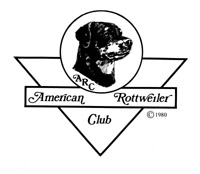This is a dog that normally is very alert and responsive to his surrounding and the people in it. Your attitude and stance are important to the dog’s acceptance of you a stranger, invading his area. Approach him in a deliberate, confident and friendly manner. When first approaching, (slightly at an angle, from the front) to assess head type and expression, do not at the dog, directly in the eyes, as this can be perceived as a challenge to the dog. You can assess ear set, eyes, head proportions without staring. Ask the handler to show the dentition (with understanding that there are 42 teeth, and one missing is a serious fault, and two missing is a disqualification). Examine the body, testicles and tail (if natural) with gentle firm hands. It takes very little “hands on” examination to judge a Rottweiler. Rottweiler do not require a heavy touch and may resent it. Structure and movement is easily determined by moving them.
Not all Rottweilers enjoy being examined by a stranger, but all Rottweilers can be trained to do so. Just in case you meet that one in a thousand that is not, approach from the front, but slightly at angle, shoulder down, at ease yet confident. This is the submissive position, which have learned from temperament testing. You are no threat. Stand at the side of the dog when checking the teeth and body. Go over the dog quickly and smoothly, checking for the undercoat and the texture of the outer coat, testicles and tail. Colder climates can produce thicker coats, this is normal.
DOs and DON’Ts of Approaching, Examining and Handling Rottweilers in the Ring
- DO remember to give each entry the same consideration and ring pattern.
- DO realize that large entries mean more novice handlers. Your understanding can make the novice handler want to become the pro of the future.
- DO have the large classes lined-up in catalog order for your ease in checking the number in your judge’s book, for the ring stewards, exhibitors, and spectators ease in keeping track of the entries, to say nothing of the videographers and photographers.
- DO, when possible, split large classes and excuse the group being judged from the ring. A ring full of Rottweilers gating next to a ring of waiting Rottweilers can cause some unwanted disruptions of the judging process.
- Do as the handlers, when gaiting the dogs to keep their space, not run-up on the dog in front of them, and always gait the dog at a moderate speed and under control. It is your ring; it is NOT the “INDY 500!” Do respect the character of the breed when you go to approach and examine the individual dog. Not all Rottweilers enjoyed being examined by a stranger, but all Rottweilers can be trained to do so. Just in case you meet that one in a thousand that is not, approach from the front, but slightly at an angle, shoulder down, at ease, yet confident. This is the submissive position, which we have learned from temperament testing. You are no threat. Stand at the side of the dog when checking the teeth and body. Go over the dog quickly and smoothly, checking for the undercoat and texture of the outer coat, testicles and the tail, if natural. Remember that the undercoat is greatly affected by the climate.
- Do keep your hand(s) on the dog while examining and avoid the temptation to reach back to touch the dog once you have completed your exam, once you have removed your hands.
- Do ask the handler to show the bite and dentition. If the handler is having trouble, you have the option of asking to see the gait which may settle the dog down so you can proceed with the individual examination alleviating the necessity of having to excuse a dog that could not be examined on that day.
- DON’T be a “hero”. If you feel the dog cannot on this day be examined safely, excuse him. If the dog is causing a continual disruption in your ring affecting the other entries, excuse him.
- DON’T over examine a Rottweiler. You can see most of what you need to know especially when moving the dog.
- DON’T grab the head, massage the dog, pinch the thighs, bend over the dog, pull legs out from behind, do NOT kneel in front of the dog or stare at him in the eyes.
- DON’T reposition or restack the dog for the handler. The dog may tolerate his own handler, but not a stranger.
- DON’T judge Rottweilers until you feel completely comfortable with the breed. Rottweilers can sense when a person is nervous, and it may put them on guard. Set up a visit or with the mentors listed on the ARC website and get your hands on their dogs. They can demonstrate how to handle them with confidence.
And finally, DO remember that the exhibitor, by asking for your opinion on his dog, has given you the greatest compliment you can have in the dog world. This is your ring, your domain, but also your responsibility. The “buck stops” with you, the judge.



